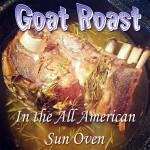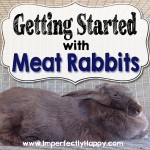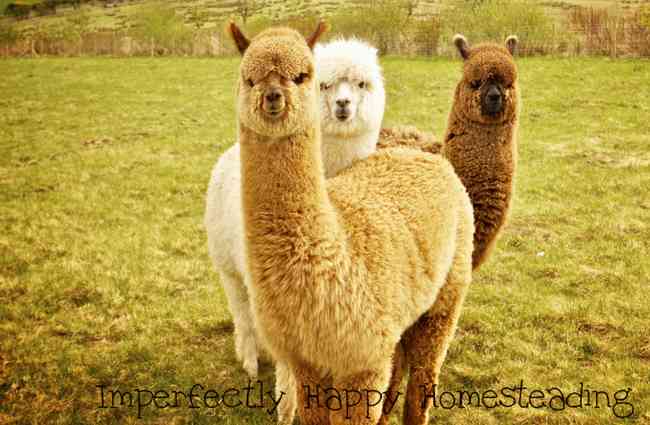 Getting Started with Alpacas – Mystic Pines Alpaca Ranch.
Getting Started with Alpacas – Mystic Pines Alpaca Ranch.
A few weeks ago my family and I took a mini vacation just a few hours from Phoenix. One of our must-see stops was an alpaca farm tour, that I had found online. My 19 year old daughter loves alpacas and llamas so I knew this would be the highlight of the trip for her; well it turned out to be a highlight for all of us. We were all so impressed with Rob and Donna’s Mystic Pines Alpaca Ranch, their fiber mill and their beautiful alpacas that I came home and wrote to them about sharing on Imperfectly Happy; they agreed. So if you’re interested in getting started with alpacas I think Rob has some great information to share.

My girls getting to feed the alpacas with Ron from Mystic Pines Alpaca Ranch
In this post, Rob is going to share about alpacas, alpaca fiber and their mill. In their next post they’ll be sharing about their ideas for sustainable (off-grid) living and their fiber mill. Enjoy!
Welcome to Mystic Pines Alpaca Ranch!
My wife, Donna, and I got into raising alpacas approximately five years ago. Many years ago, we had seen all of the 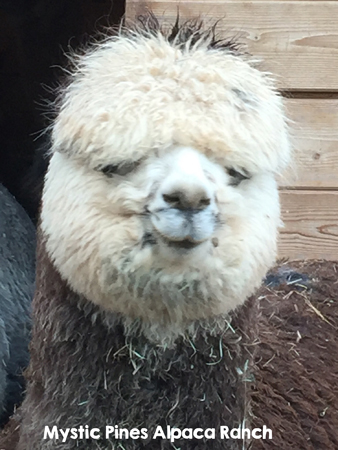 get-rich-quick advertisements on television. Although we did not agree with that aspect of raising alpacas, we did like the looks of the animal. More than that however, after doing some research, they are relatively easy animals to care for and at the end of the day you can harvest an end product from them. That product is their fiber!!
get-rich-quick advertisements on television. Although we did not agree with that aspect of raising alpacas, we did like the looks of the animal. More than that however, after doing some research, they are relatively easy animals to care for and at the end of the day you can harvest an end product from them. That product is their fiber!!
Getting Started with Alpacas
Researching the alpaca industry should be your first step if you are considering raising alpacas. It would be beneficial to visit as many alpaca ranches as you can. Talk to the owners and get a feel for what raising alpacas entails. A great on-line resource is through the Alpaca Owners Association at www.alpacainfo.com. For the most part, there are two reasons to raise alpacas. Many people raise alpacas for their fine fleece. Some people, however, enjoy the show ring. There are many competitions across the country throughout the year. Your alpacas would compete with other alpacas in the same age and color category. They are judged mostly on the fineness of their fiber as well as their conformation. Shortly after we started raising alpacas, we went to Denver to compete in the national competition to show two of our animals. After that weekend, we determined that the show ring was not for us. That’s when we decided to concentrate on the fiber end of our business.
Alpacas are a herd animal and like to stay in groups. For this reason, you would want to have no less than three alpacas. Their natural instinct is strength in numbers in the event of a predator attack. They are very curious animals but don’t necessarily like to be touched. Although with frequent human interaction they can be very friendly.
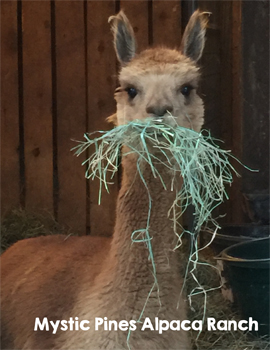 Their diet consists mainly of orchard grass hay and water. During pregnancy and after birth, we will feed them alpaca pellets. This gives the new mothers added protein while they are nursing their cria (baby alpaca). The new mothers can use all of the nutrition they can get during this time period, so we tend to keep them separated with their cria from the rest of the herd, but with a few other females for companionship. Powdered mineral is also there for them to eat whenever they want.
Their diet consists mainly of orchard grass hay and water. During pregnancy and after birth, we will feed them alpaca pellets. This gives the new mothers added protein while they are nursing their cria (baby alpaca). The new mothers can use all of the nutrition they can get during this time period, so we tend to keep them separated with their cria from the rest of the herd, but with a few other females for companionship. Powdered mineral is also there for them to eat whenever they want.
Getting Started with Alpacas
Some questions you should ask yourself prior to purchasing an alpaca are:
1. Can I afford it?
We purchase all of our hay. It would be cost prohibitive to actually irrigate pasture for grazing in northern Arizona. If you can graze your animals, that is definitely money saved!! An alpaca will eat roughly a bale of hay per month. So feed costs are not terrible, but the more animals you have, the more the hay costs add up.
You will need someone to shear the animal once a year. Get a good shearer who knows what they are doing. You have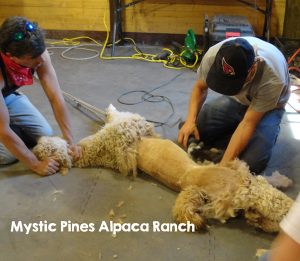 a year invested into the growing of the fiber. You do not want someone coming along and jeopardizing the staple length of your fiber by doing multiple second cuts, or mixing seconds and thirds together with the blanket!! All of the fiber, for the most part, can be used for one thing or another. The prime fiber of your alpaca (called the “blanket”), which is the mid-section of the animal, is generally used for roving or spun-up yarn.
a year invested into the growing of the fiber. You do not want someone coming along and jeopardizing the staple length of your fiber by doing multiple second cuts, or mixing seconds and thirds together with the blanket!! All of the fiber, for the most part, can be used for one thing or another. The prime fiber of your alpaca (called the “blanket”), which is the mid-section of the animal, is generally used for roving or spun-up yarn.
- What should I look for in a good fiber animal?
When looking for an alpaca, if you’re going to try and do something with the fleece, look for a good staple length (the overall length of your animal’s fiber). Another thing to look for is the “crimp” (the kinky/wavy characteristic of the fiber). The higher the crimp of the fiber, the better the fiber is. The crimp and a long staple length will help hold the fiber together when being processed into yarn. Also, if it is available, ask for a micron count of the animal’s fiber. The lower the micron count, the finer and softer the fiber is.
- What can I do with all of this fiber?
There are many options as to what to do with your bags of freshly shorn fiber. You can sell it raw. Generally, if you have a really nice fiber, you can get a pretty good price for it in its raw state. You can send it to a mill to have it processed into yarn or into roving for hand spinners and felting. Some of the courser fiber can be made into rug yarn. Leg fiber can be put at the base of plants in the garden to help retain moisture. There are all kinds of different craft ideas that your fiber can be used for.
So, as I mentioned, it is good to do a lot of research prior to making the decision to start raising alpacas. Raising  alpacas can be grown into a lucrative business, but the margins are very tight. From a homesteading aspect they are a great animal to raise and, at a minimum, can get you some kind of a return on your investment.
alpacas can be grown into a lucrative business, but the margins are very tight. From a homesteading aspect they are a great animal to raise and, at a minimum, can get you some kind of a return on your investment.
Here at Mystic Pines we took it a step further and purchased a fiber processing mill to process not only our own fiber, but also other fiber animal owners as well. This was a huge undertaking as well as an expensive one. But so far business has been good and we continue to grow every year. We offer tours of our alpaca and milling operation. You can go to www.mysticpinesfiber.com and click on the tours tab (and they are on Facebook)
In part two of this blog, I will go into greater detail about the fiber mill and also cover our sustainability here at Mystic Pines!



